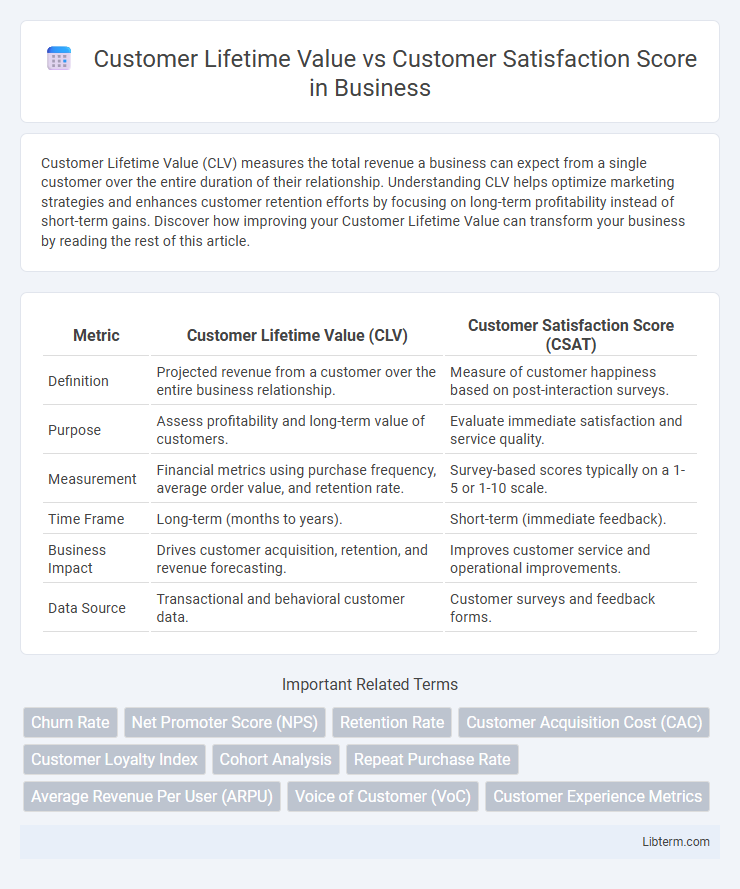Customer Lifetime Value (CLV) measures the total revenue a business can expect from a single customer over the entire duration of their relationship. Understanding CLV helps optimize marketing strategies and enhances customer retention efforts by focusing on long-term profitability instead of short-term gains. Discover how improving your Customer Lifetime Value can transform your business by reading the rest of this article.
Table of Comparison
| Metric | Customer Lifetime Value (CLV) | Customer Satisfaction Score (CSAT) |
|---|---|---|
| Definition | Projected revenue from a customer over the entire business relationship. | Measure of customer happiness based on post-interaction surveys. |
| Purpose | Assess profitability and long-term value of customers. | Evaluate immediate satisfaction and service quality. |
| Measurement | Financial metrics using purchase frequency, average order value, and retention rate. | Survey-based scores typically on a 1-5 or 1-10 scale. |
| Time Frame | Long-term (months to years). | Short-term (immediate feedback). |
| Business Impact | Drives customer acquisition, retention, and revenue forecasting. | Improves customer service and operational improvements. |
| Data Source | Transactional and behavioral customer data. | Customer surveys and feedback forms. |
Understanding Customer Lifetime Value (CLV)
Customer Lifetime Value (CLV) quantifies the total revenue a business can expect from a single customer over the duration of their relationship. By analyzing purchase frequency, average order value, and customer retention rates, companies gain insights into long-term profitability. Unlike Customer Satisfaction Score (CSAT), which measures immediate contentment, CLV emphasizes the cumulative financial impact of customer loyalty and engagement.
Defining Customer Satisfaction Score (CSAT)
Customer Satisfaction Score (CSAT) measures customer contentment with a product or service through direct feedback, typically obtained via surveys rating satisfaction on a numerical scale. It reflects immediate customer perceptions and is calculated by dividing the number of satisfied customers by the total respondents, then multiplying by 100 to get a percentage. Unlike Customer Lifetime Value (CLV), which estimates the long-term financial value of a customer, CSAT focuses on short-term satisfaction to gauge service quality and improve customer experience promptly.
Key Differences Between CLV and CSAT
Customer Lifetime Value (CLV) quantifies the total revenue a business expects from a single customer throughout their relationship, emphasizing long-term financial impact. Customer Satisfaction Score (CSAT) measures a customer's immediate contentment with a product or service, highlighting short-term experience quality. CLV drives strategic marketing and retention initiatives, while CSAT focuses on operational improvements and customer service effectiveness.
Why CLV Matters for Business Growth
Customer Lifetime Value (CLV) quantifies the total revenue a business can expect from a single customer over the entire relationship, making it a critical metric for sustainable business growth. Higher CLV indicates stronger customer loyalty and increased repeat purchases, which directly contribute to profitability and long-term success. While Customer Satisfaction Score (CSAT) measures short-term happiness, CLV provides a strategic insight into customer retention, guiding resource allocation to enhance lifetime engagement and maximize financial returns.
The Impact of CSAT on Customer Retention
Customer Satisfaction Score (CSAT) significantly influences Customer Lifetime Value (CLV) by directly affecting customer retention rates. High CSAT indicates positive customer experiences, leading to increased repeat purchases, higher loyalty, and reduced churn, which collectively enhance CLV. Businesses that prioritize improving CSAT typically see stronger retention metrics, driving long-term revenue growth and sustainable profitability.
Measuring CLV: Metrics and Methods
Measuring Customer Lifetime Value (CLV) involves metrics such as average purchase value, purchase frequency, and customer lifespan to estimate future revenue from a customer. Methods include historical data analysis, predictive modeling using machine learning, and cohort analysis to forecast long-term profitability. Accurate CLV measurement helps businesses allocate resources efficiently and tailor strategies to maximize customer retention and value.
Evaluating CSAT: Tools and Techniques
Customer Satisfaction Score (CSAT) evaluation involves tools such as customer surveys, feedback forms, and sentiment analysis platforms that capture real-time user sentiment and satisfaction levels. Techniques like Net Promoter Score (NPS) integration, text analytics for qualitative feedback, and statistical analysis of survey data help businesses accurately assess customer satisfaction trends. Leveraging these tools and methods enables organizations to identify pain points, improve service quality, and enhance overall Customer Lifetime Value (CLV) by fostering long-term loyalty.
How CLV and CSAT Influence Business Decisions
Customer Lifetime Value (CLV) and Customer Satisfaction Score (CSAT) critically inform business decisions by quantifying long-term profitability and immediate customer experience. High CLV directs investment towards customer retention strategies, while elevated CSAT highlights areas for operational improvement and service quality enhancement. Balancing these metrics enables companies to optimize marketing budgets, prioritize product development, and tailor customer support initiatives for sustainable growth.
Integrating CLV and CSAT for Strategic Advantage
Integrating Customer Lifetime Value (CLV) and Customer Satisfaction Score (CSAT) offers businesses a strategic advantage by aligning long-term profitability with customer experience metrics. High CLV customers showing elevated CSAT scores indicate loyalty drivers, guiding targeted retention efforts and personalized marketing. Leveraging combined CLV and CSAT data enables predictive insights that optimize customer segmentation and resource allocation for maximizing revenue growth.
Best Practices to Improve Both CLV and CSAT
Maximize Customer Lifetime Value (CLV) and Customer Satisfaction Score (CSAT) by implementing personalized customer engagement strategies that foster loyalty and repeat business. Employ accurate data analytics to monitor purchasing behaviors and satisfaction trends, enabling targeted improvements in product offerings and customer support. Invest in proactive communication and resolving issues promptly, as high responsiveness directly enhances customer satisfaction and encourages long-term retention.
Customer Lifetime Value Infographic

 libterm.com
libterm.com